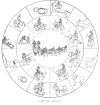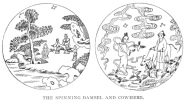
Chinese Occultism, by Paul Carus, [1907], at sacred-texts.com

Chinese Occultism, by Paul Carus, [1907], at sacred-texts.com
To the Chinese (as also in some respects to the Babylonians) the stars are actual presences who sway the destinies of mankind, and we reproduce here a series of illustrations from a Buddhist picture-book printed in Japan. They are based upon ancient traditions ultimately derived from Sumer and Accad, but we have at present no means to determine the question of their history, especially as to their fate in China. One thing, however, may be regarded as certain, viz., that their traditional forms are prior to the calendar reform of the Jesuits. Hence we must assume that they have been imported by the way on
land either by the Buddhists from India, or through some earlier civilising influences perhaps from ancient Babylon, or may be in later times from Greece by way of Bactria and Tibet. An historical
connection of some kind or other with Western astronomy which also derives its origin from ancient Babylon, can scarcely be doubted; for the general similarities are too pronounced, and the more particular
ones serve as obvious evidences which cannot be rejected, while the differences afford suggestions in regard to their development and fate.
According to the Chinese and Japanese custom, the series begins in the right upper corners and the order proceeds downwards and to the left.
The first figure represents the sun; the second, the moon. In
the next row we see the polar star seated (like Buddha) on a lotus and holding in his hands a wheel to indicate that he is the hub of the heavens. As Buddha in the spiritual world, so the polar star
among the constellations is alone at rest while all other things in the universe whirl round in unceasing rotation. In the same column is the star of twilight-brightness, which may be either the morning or evening star.
The third row of the same page begins the series of stars that constitute Ursa Major, popularly called "the dipper" in America and known in China as "the bushel."
The satellite of the seventh star in Ursa Major is pictured as a smaller companion in the right hand corner in the field of his bigger brother. Since he stands at the very point of the constellation,
his significance is in inverse proportion to his size, in a similar way as Tom Thumb always takes the initiative in all deeds and proves to be the saviour of his seven brothers.
The seven stars of Ursa Major are very conspicuous in the northern firmament, and turn around in the sky like a big hand on the celestial dial pointing out the hour in the clock work of the
universe. There is a proverbial saying in China which incorporates the popular Chinese view as follows:
"When the handle of the northern bushel (Peh Tao) points
east at nightfall it is spring throughout the land; when it points south, it is summer; when west, it is autumn; and when north, winter."
The three stars ι, κ, λ. of Ursa Major are supposed to be the
residence of the three councilor spirits mentioned in the Kan Ying P‘ien as recording the deeds of men, and thus our constellation is symbolically identified in the imagination of the Chinese, with divine justice.
The seven planets are here increased after the precedence of Hindu astrology by two three-headed figures called Rahu and Ketu, the former being conceived as the head, and the latter as the tail of
the dragon who is supposed to be responsible for solar and lunar eclipses. Rahu represents the ascending and Ketu the descending nodes in the ecliptic.
The nine personalities which correspond to the seven planets plus Rahu and Ketu are in Hindu mythology called: Surya, the Sun; Chandra, the moon; Mangala, Mars; Buddha, Mercury; Vrihaspati, Jupiter; Sukra, Venus; Sani, Saturn; while Ketu and Rahu
are identified with stars in the Dragon. Rahu is represented headless and Ketu as a trunkless head. A representation of this Hindu notion is found in Colonel Stuart's zodiac picture reproduced in Moor's Hindu Pantheon, Plate XLVIII. It shows Surya the sun in the center drawn by seven horses, with Aruna as charioteer. Surya in the colored original is in gold, while Aruna is painted deep red. Chandra rides an antelope, Mangala a ram, Buddha is seated on a

Click to enlarge
A HINDU ZODIAC.
carpet; Rahu and Ketu here interrupt the regular order, the former being represented as riding on an owl, while the latter, a mere head, is placed on a divan. Vrihaspati like Buddha is seated on an animal that may have been intended for a cat, while Sani rides on a raven.
Next in order on our tables beginning with the second column

Click to enlarge
THE ARMILLARY SPHERES OF THE PEKING OBSERVATORY
of their fourth page, are the twenty-eight constellations mentioned above which play an important part in Chinese occultism. The ap-
proximate outline of the constellation is indicated in each case above the picture, and we see, for instance, why the fifteenth constellation is called "astride," and the twenty-sixth, a "drawn bow."
We add here to our illustrations of stars a picture of Chih Nü and Keng Niu, the stars Vega and Aquila on either side of the Milky Way, of which Chinese folklore tells one of the prettiest fairytales of China. It is briefly thus: The sun-god had a daughter Chili Nü (star Vega = α in Lyre) who excelled by her skill in weaving and her industrial habits. To recompense her he had her

Click to enlarge
THE SPINNING DAMSEL AND COWHERD.
A Chinese fairy tale of the star Vega. A native illustration from Williams's Middle Kingdom.
married to Keng Niu the herdsman (constellation Aquila), who herded his cattle on the silver stream of heaven (the Milky Way). As soon as married, Chih Nü changed her habits for the worse; she forsook her loom and gave herself up to merry-making and idleness. Thereupon her father decided to separate the lovers by the stream and placed them each on one side of the Milky Way, allowing the husband to meet his wife over a bridge of many thousand magpies only once a year, on the seventh day of the seventh month, which is a holy day in China even now.
We know that the Chinese government has kept an imperial

Click to enlarge
OBSERVATORY OF PEKING. GENERAL VIEW.
astronomer since prehistoric times, for the office is mentioned in the earliest documents. The famous emperor Kang Hi erected
a new observatory which was built according to the instructions of the Jesuit fathers whose learning at that time was highly respected

Click to enlarge
SPHERICAL ASTROLABE OF THE PEKING OBSERVATORY
in China. The instruments remained at Peking until the Boxer riots when they were removed to Germany at the command of Emperor William.
Our illustrations will enable the reader to form a clear conception of the instruments as well as the style in which they have been put up. They stand on a high platform overlooking the city, surrounded by battlements in the style of an old fortress. One general view is a reproduction of an old cut at the time of the erection of the observatory under the Jesuit fathers. The other one is a photograph made in modern times and showing the instruments in situ before their removal to Potsdam.
The gem of the collection is decidedly the spherical astrolabe which has been made after the instructions of Ko Chow King, astronomer royal of emperor Tai Tsu, of the Yüan dynasty, the founder of Peking. It is said to be a marvel of Chinese art. In the general view we notice a quadrant on the left-hand side between two light columns in French style. It is a present of King Louis XIV sent to the emperor Kang Hi in the seventeenth century. Among the instruments preserved in the shed there are some curios of great artistic and historical value. The whole observatory as it stood has always been regarded as one of the most noteworthy treasures of the Tartar capital of the Celestial Empire.
66:* We wish to express here our indebtedness to the National Museum and its officers, and especially to Prof. Otis T. Mason and Mr. George C. Maynard. for the reproduction of characteristic specimens of this interesting collection.